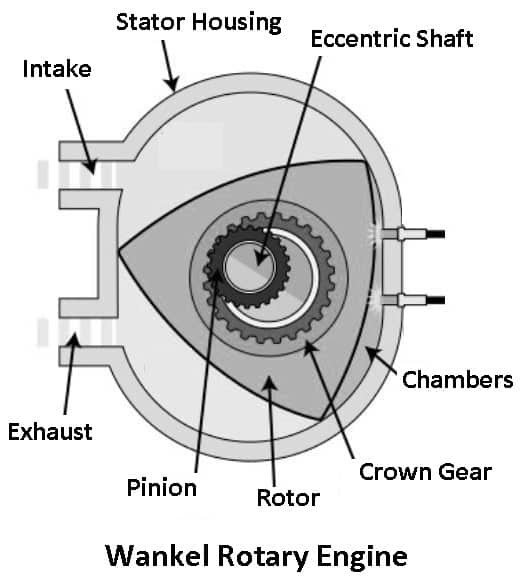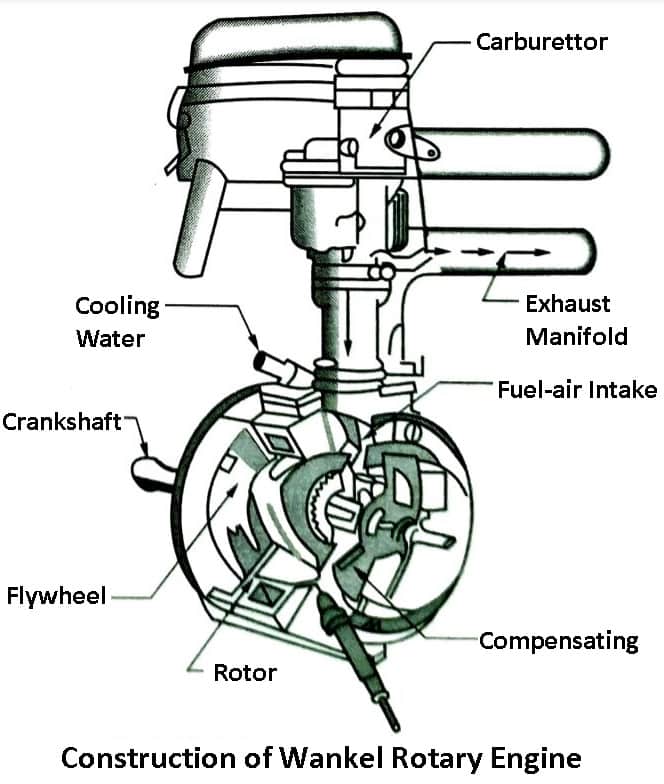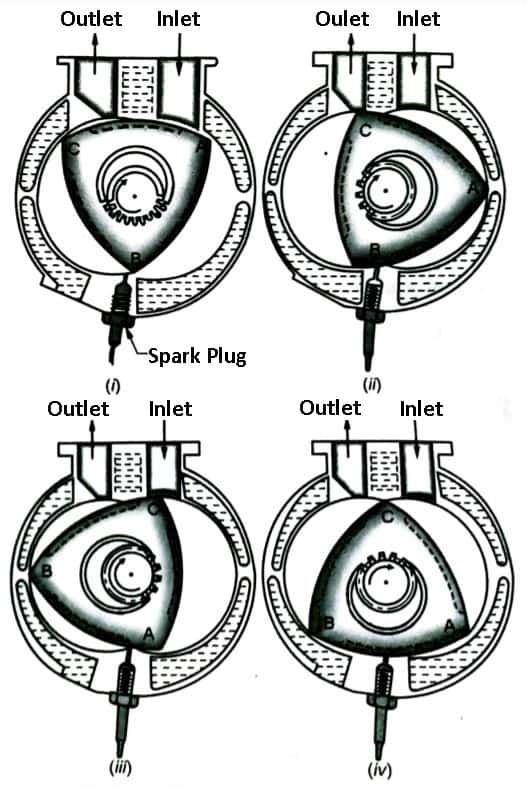Hello readers! In this post, we’ll discuss the What is Wankel Engine? Its Working, Types, Advantages, and Comparison of Rotary and Piston Engine.
All over the world, engines are most frequently used. All vehicles now include them as a crucial component. According to the requirements of various applications, there are various types of engines.
One of the most well-known varieties of internal combustion engines is the Wankel engine. It produces power through a rotating rotor. Throughout this article, you will be able to find information about the working of Wankel engines, their types, parts, and applications.
What is Wankel Rotary Engine?
It is defined as a rotary internal combustion engine in which a curved, triangular, or eccentrically pivoted piston rotates in an elliptical chamber, creating three combustion spaces that differ in volume. Or in simple words, it is an internal combustion engine that uses an eccentric rotary design to convert pressure into rotational motion.

The German engineer Felix Wankel invented the rotary engine known as the Wankel rotary engine, which was mostly used in race cars. The Wankel engine works on the ordinary Otto cycle but differs from the reciprocating I.C. engines.
It is purely a rotary engine having no reciprocating part or piston. Compared to reciprocating piston engines, Wankel engines provide more torque, less vibration, and, for a given power, are more compact and weigh less.
It makes use of a rotor instead of a piston, which turns inside a chamber. This design gives a new challenge to the existing reciprocating engines.
Read Also: What are the parts inside a Car? [Explained with Diagrams]
Parts of Wankel Rotary Engine
Following are the parts of a Wankel rotary engine:
- Intake
- Exhaust
- Crown gear
- Rotor
- Combustion chamber
- Housing
- Eccentric shaft
- Apex seal
- Spark plug

#1 Intake
The intake starts when the rotor tip passes through the intake port. At this point, the chamber is at its smallest position and expands as it spins.
#2 Exhaust
When the tip passes through this exhaust port, high-pressure exhaust gas can flow through this port.
#3 Crown Gear
In the Wankel engine, the crown gear has teeth that project at right angles to the face of the wheel.
#4 Rotor
The Wankel rotary engine commonly uses a triangular-shaped rotor. This rotor consists of three convex faces. Every face acts as a piston. The rotor works as a prime mover in the Wankel rotary engine.
The combustion is generated by burning the fuel and is applied directly to the rotor, so it spins eccentrically. On one side of the rotor, it has an internal timing gear that mashes with the fixed timing gear located on the side housing to keep the correct connection between the rotor and the eccentric shaft.
#5 Combustion Chamber
The rotor in the Wankel engine rotates with an orbital motion in a specially shaped housing and makes the crescent-shaped combustion chambers between its sides and the curved wall of the housing.
#6 Housing
It is an oval-like epitrochoid-shaped housing enclosing a triangular rotor with bow-shaped faces that resemble a Reuleaux triangle. The housing includes an inlet, outlet port, spark plug, water jacket, etc.
This engine has several housings, with two housings that are important, they are:
- Main Housing: It is closed using side housings.
- Side Housing: It consists of a fixed timing gear that matches the internal timing gear. It keeps the correct connection between the rotor and the eccentric shaft.
#7 Eccentric Shaft
It is the useful part used to convert the eccentric motion of the rotor into concentric motion and take it out of the engine.
The rotors ride on an eccentric (corresponding to a crankpin) integral to the eccentric shaft (corresponding to a crankshaft). The rotor rotates around the eccentrics and makes an orbital rotation around the eccentric shaft.
#8 Apex Seal
The sides of the triangular rotor act as pistons, so this chamber must be sealed. To seal the chamber, the apex seals are used. They are made of curved metal placed in contact with the engine housing when the rotor moves.
#9 Spark Plug
The Wankel engine uses two spark plugs, i.e., a leading and a trailing spark plug. The leading plug (located at the bottom of the rotor housing) burns up to 95% of the air/fuel mixture providing much power.
You might like: What is the Difference Between Petrol and Diesel Engines?
Construction of a Wankel Engine

Figures show a simplified diagram of the Wankel Rotary Engine. It consists of a three-lobe rotor (a rotor of tri-angular shape with curved sides), that rotates eccentrically in an oval chamber. The rotor is mounted on the crankshaft through external and internal gears.
The rotor lobes are sealed tightly against the sides of the oval chamber. The combustion of rotor and chamber shapes ensures that they remain in contact with each other throughout the rotation. The rotor has an oval-shaped depression on its three sides between the lobes.
Read Also: How does a Turbocharger work? Advantages & Disadvantages with PDF
Wankel Engine Working
A Wankel rotary engine is an internal combustion engine that operates on the fundamental Otto-cycle concept.
A four-stroke Wankel engine operates in the following manner:
#1 Suction Stroke
During this stroke, when the rotor’s tip passes through the inlet port, fresh air starts to enter the first cylinder. Fresh air is still drawn into the first cylinder until the second tip of the rotor contacts the inlet port and closes it. The intake port then closes, trapping the new fuel-air mixture for compression and combustion in the first cylinder.
#2 Compression Stroke
When the intake stroke is finished, the trapped air-fuel mixture begins its compression stroke. Due to the rotation of the rotor, the gap between corner 1 and corner 2 of the first cylinder reduces, so the mixture volume is reduced, and it is compressed. According to the requirements, the air-fuel mixture is compressed and then sent for combustion.
#3 Power Stroke
To ignite the air-fuel mixture inside the first cylinder (between 1 and 2 corners), a spark plug introduces a spark inside the cylinder. The mixture becomes high-temperature and pressure gases as a result of the ignition.
The rotor moves forward due to the energy of the combusted mixture. Until the first corner passes by the exhaust port, this process continues.
#4 Exhaust Stroke
The engine’s high-pressure burning gases are released when corner 1 contacts the exhaust port. The exhaust port closes after releasing exhaust gases, and the cycle is repeated.
Take a look at the following video for a better understanding:
You might like: Understand the Working of Timing Belt in Car
How Wankel Engine Works?
Typically, a Wankel rotor engine has a three-lobe rotor, which forms three spaces around it in an oval chamber. The four main cycles of intake, compression, power, and exhaust run simultaneously in three places around the rotor during the engine are operating.

Figures (i) represent the fuel intake, in which the rotor side AB creates suction. The mixture of the air/fuel from the carburetor enters the suction chamber. As the rotor turns clockwise, the mixture is compressed between the rotor and the chamber as at (ii).
Further, it is ignited, burnt gases expand, turning the rotor, as at (iii), and finally, the exhaust gases are pushed out of the chamber as at (iv). The rotor side AB is again in the initial position to take the new charge. Thus, the cycle is complete.
The same cycle of operations goes on on all three sides of the rotor simultaneously. There are three power impulses in every revolution of the rotor, which is three times compared to a two-stroke engine and six times compared to a four-stroke engine.
The engine delivers power almost continuously. The eccentric motion of the rotor produces vibrations, which are reduced by using a symmetrically mounted flywheel.
You might like: What is the function of a Single Cylinder Engine?
Why is the Wankel Engine so uncommon?
Nowadays, Wankel engines are uncommon due to the following reasons:
#1 Low Thermal Efficiency
The Wankel engine’s combustion chamber is long and irregular in shape. As a result, its thermal efficiency is lower than that of reciprocating engines. Unburned fuel frequently escapes the tailpipe as a result of this.
#2 Burn Oil
These engines burn oil because of their design. This engine’s intake manifold has squirters and an injector that pumps oil directly into the burner. Because of this, the exhaust emits more harmful substances. The environment dislikes harmful substances.
#3 Rotor Sealing
The rotor sealing of a rotary engine can be challenging when the temperature around the rotor varies greatly. This issue raises the engine’s emission rate.
Remember that the suction and burning processes happen simultaneously but in different parts of the engine housing. This indicates the temperature at the top of the engine housing is lower than at the bottom.
#4 High Emission Rate
Wankel rotary engines are not well known due to their high emission rate. Engines that fail to meet current fuel economy or emissions standards are caused by sealing difficulties, inherent oil combustion, and inefficient combustion.
#5 Poor Fuel Economy
Compared to reciprocating engines, Wankel engines consume more fuel—high fuel consumption results in higher fuel prices.
You might like: What Is Knocking In Engine? [Their Causes & Remedies]
Advantages of Wankel Rotary Engine Over Reciprocating Engine
- Wankel rotary engine is smaller in size, lighter in weight, and more compact than reciprocating engines.
- It is cheaper and simpler in construction for mass production due to the absence of many working parts like connecting rods, crankshafts, valve mechanisms, etc.
- Its balancing is easier because it does not contain any reciprocating parts. Road tests have proved that this engine is practically free of vibrations.
- Wankel engine volumetric efficiency is very high, often exceeding 100%.
- Its power output per kg of the engine is considerably higher.
- The Wankel engine requires a lower running cost than the reciprocating engine.
- It does not require overdrive because its speed is very high.
Disadvantages of Wankel Engine
- Higher fuel consumption at low-speed ranges and higher oil consumption per B.H.P.
- Lower torque speeds.
- The braking effect of the engine is far less.
- Reduction of speed in the transmission is necessary due to the very high engine speed.
- Due to the ignition troubles experienced with ordinary ignition system. Spark plugs need to be changed periodically. However, this has been removed by using transistorized ignition.
- The main obstacle in the development of the Wankel rotary engine was the sealing problem, which has largely been solved.
- Cylinder distortion may occur due to the close proximity of the inlet and exhaust ports.
- Very high exhaust gas temperatures, nearly 1600°F, creates problem in the exhaust manifold and silencer designs.
You might like: Everything You Need To Know About The Starter Motor
Applications of Wankel Rotary Engine
Following are the applications of the Wankel rotary engine:
- The Mazda 12A engine was the first engine to be built with a Wankel engine.
- It is specifically designed to produce a light, reliable, and relatively powerful engine for use in aircraft.
- Motorcycle manufacturers also prefer Wankel engines due to their small size and attractive power-to-weight ratio.
- Due to the compact size and high power-to-weight ratio of the Wankel engine, it has been suggested that electric vehicles provide supplemental power when electric battery levels are low.
- Smaller Wankel engines are increasingly observed in other applications, such as auxiliary power units for go-karts and personal watercraft.
- The Wankel engine’s simplicity makes it suitable for mini, micro, and micro-mini engine designs.
Difference Between Rotary Engine and Reciprocating Engine
| Rotary Engine | Reciprocating Engine |
|---|---|
| A rotary engine has four separate sections, and each one performs a specific job: intake, compression, combustion (or ignition), or exhaust. | A reciprocating engine is one of two types of combustion engines, which work by combusting fuel to create energy. |
| A rotor rotary engine has three moving parts, that is, two rotors and an output shaft. | Simple reciprocating engines have at least 40 moving parts. |
| In rotary engines, the rotor rotates continuously in one direction. | Compared to a reciprocating engine, the pistons change direction suddenly. |
| The main moving parts in a rotary engine move at a slower speed, so it improves reliability. | In a reciprocating engine, the main moving parts move at high speed, so it reduces reliability. |
Closing It Up
As far as we discussed, there are many benefits of the Wankel engine, and there are also many drawbacks. These engines have their place in this world, however, due to the increased maintenance to keep them running well and the costs associated with driving one.
Now, I hope you have learned about the “Wankel Rotary Engine” and found something you haven’t heard before. Still, if you have any questions or doubts regarding this article, feel free to ask in the comments, and I will respond. So, if you liked this article, please share it with your friends.
Want Free PDFs in your inbox? Then subscribe to our newsletter.
Download the PDF file of this article:
You might want to read more articles in our blog:
- What is the main function of a suspension system in a Car?
- How do Disck Brakes differ from Drum Brakes? PDF
- Top 10 Easy Tips to Save Fuel while Driving.
- What are the different types of fuel injectors used in engines?
- Types of Fuel Gauge – How It Works?
- Types of Fuel Pumps and Its Working Principle
- Basic Parts of Motorcycle & Their Functions [Explained]
- 25 Main Car Dashboard Lights and Their Meaning
External Links:
Frequently Asked Questions
Compared to reciprocating piston internal combustion engines, the Wankel engine has advantages such as compact design, smoothness, lower weight, and fewer parts.
The Wankel engine is suitable for range extenders in automobiles, jet skis, snowmobiles, auxiliary power units, aircraft, and loitering munitions.
Wankel engines typically have a maximum fuel efficiency of around 30%. Because the combustion chamber in a Wankel rotary engine is long, thin, and moving, fuel combustion occurs slowly.
Yes, a turbocharged or supercharged Wankel engine is possible. Wankel engines can be turbocharged or supercharged to improve their performance by increasing their power and torque output.
Yes, applications for the Wankel engine include hybrid and electric vehicles. It is crucial to remember that the Wankel engine isn’t often used as the main power source in these applications but rather as a range extender. Wankel engines in hybrid vehicles serve as generators to charge electric batteries, extending their range and reducing their reliance on internal combustion engines. Wankel engines serve as backup generators in electric vehicles, allowing for increased driving range when batteries deplete.
Loved this …plz drop me the pdf ….thanx in advance
Thanks for your feedback. The PDF file has been sent to your inbox.
THANKS dear for your response
You’re welcome.
Dear MD Ilyas, thanks dear for an elaborate picturesque view of Wankel Rotary Engine. Do we use AB Washers in this Engine? Also can we design a Genset involving Wankel Engine for first Charge and then keeping it moving with
Electromagnetic Induction, Capacitors, Battery, Alternator etc. In a Loop. Please advise
Unfortunately, Gensets won’t do well but, tiny gensets are OK to run on petrol but real ones run on diesel. Always buy a diesel that runs at 1,500 rpm. Try to get a small diesel of 8 or 10hp to run a 12 volt & 24v alternator charging 12v & 24v battery banks via an alternator controller for a much faster charge. Then use inverters to get mains power from the batteries. This way you can reduce genset runtime by about a third, and/or run off batteries at night or other quiet times. Hope this help
You are doing a wonderful assistant to some of us that into Automobiles and mechanical engineering thanks so much
I’m Glad, it helped you. Thanks for reading.